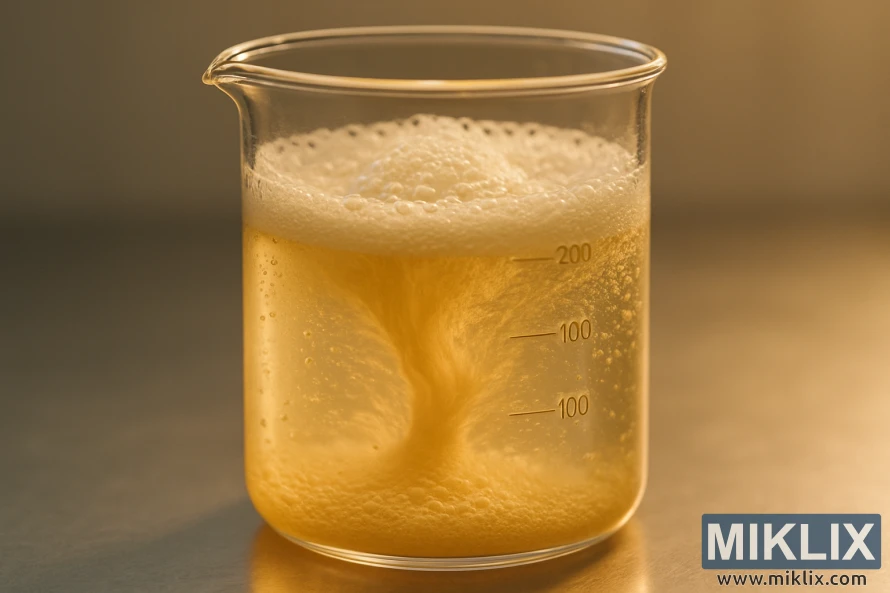Image: Close-Up of Rehydrating Yeast in Beaker
Published: July 29, 2025 at 7:35:23 AM UTC
Last updated: September 27, 2025 at 9:15:32 PM UTC
Detailed view of yeast rehydrating in a foamy, pale golden liquid, highlighting the active start of beer fermentation.
This image captures a moment of kinetic transformation within the brewing process, where biology, chemistry, and craftsmanship converge in a single vessel. At the center of the composition is a transparent glass beaker, its cylindrical form filled with a pale golden liquid that swirls with visible energy. The liquid is in motion, forming a vortex that spirals downward, pulling foam and suspended particles into its center. This dynamic movement is not random—it’s the result of a deliberate mixing or rehydration process, likely involving dried yeast cells being introduced to a nutrient-rich medium. The foam that crowns the surface is thick and frothy, a sign of vigorous activity and the release of gases as the yeast awakens and begins its metabolic work.
Tiny bubbles rise continuously from the bottom of the beaker, catching the light as they ascend and burst at the surface. These bubbles are more than aesthetic—they are the signature of fermentation in its earliest phase, where carbon dioxide is produced as a byproduct of yeast consuming sugars. The effervescence adds texture and depth to the liquid, suggesting that the yeast is not only viable but thriving. The pale golden hue of the liquid evokes warmth and vitality, hinting at the malt base that will eventually be transformed into beer. It’s a color that speaks to tradition and anticipation, the beginning of a process that will culminate in flavor, aroma, and satisfaction.
The beaker itself is marked with precise measurement lines—100 mL, 200 mL, 300 mL—reinforcing the scientific nature of the scene. These markings are subtle but essential, indicating that this is not just a casual experiment but a controlled and monitored procedure. The vessel sits atop a clean, neutral surface, and the background is softly blurred, allowing the viewer’s attention to remain focused on the swirling contents. The camera angle is slightly elevated, offering a detailed view into the vortex and the foam, as if inviting the viewer to peer into the heart of fermentation itself.
Backlighting plays a crucial role in the mood and clarity of the image. A warm, ambient glow filters through the liquid, illuminating its movement and casting gentle highlights along the glass rim and the foam’s peaks. Shadows fall softly around the base of the beaker, adding contrast and emphasizing the depth of the swirling motion. This lighting choice creates a sense of intimacy and reverence, as if the process unfolding within the beaker is something sacred—an alchemical transformation guided by time, temperature, and microbial life.
The overall atmosphere of the image is one of scientific curiosity and artisanal care. It captures the excitement of the first stages of beer fermentation, where dormant yeast cells are coaxed back to life and begin their journey of transformation. There’s a palpable sense of potential in the scene, a quiet energy that suggests something remarkable is about to unfold. The image invites the viewer to appreciate the beauty of fermentation not just as a technical process, but as a living, breathing act of creation. It’s a celebration of the invisible forces that shape flavor and experience, rendered visible in a swirl of foam, bubbles, and golden light.
The image is related to: Fermenting Beer with Fermentis SafAle S-33 Yeast

